Tribunal Statistics Quarterly: October to December 2022
Published 9 March 2023
1. Main Points
This publication presents tribunals statistics for the latest quarter (October to December, Q3 2022/23), compared to the same quarter of the previous year.
This publication does not include receipt, disposal and caseload outstanding figures for the Upper Tribunal Immigration and Asylum Chamber (UTIAC) due to this tribunal being migrated to new case management systems. This publication also excludes Employment Appeal Tribunal (EAT). The data will be made available as soon as possible, and once the data is quality assured. The total of the remaining jurisdictions is referred to in this publication and accompanying tables as the ‘Interim Total’ and has been provided to allow like-for-like comparisons over time.[footnote 1]
| Interim Totals receipts, disposals and caseload outstanding increased | In October to December 2022, the interim[footnote 1] totals for receipts increased by 7%, disposals decreased by 15% and caseload outstanding increased by 5% when compared to the same quarter in 2021/22. His Majesty’s Courts & Tribunals Service (HMCTS) recorded an interim[footnote 1] total of 81,000 for receipts. Disposals interim[footnote 1] total this quarter was 74,000 and caseload outstanding interim[footnote 1] total was 639,000. |
| SSCS receipts, disposals and caseload outstanding all increased | Compared to the same period in 2021, Social Security and Child Support (SSCS) receipts, disposals and caseload outstanding all increased by 18%, 68% and 79% respectively. The increase in receipts was driven by increases in Personal Independence Payment and Universal Credit (by 32% and 5% respectively). The increase in disposals was driven by increases in Personal Independence Payment and Universal Credit (by 87% and 73% respectively). |
| FTTIAC receipts increased, and disposals and caseload outstanding decreased | FTTIAC receipts increased by 26% in October to December 2022 compared to the same period in 2021. Disposals and caseload outstanding decreased by 24% and 9% respectively over the same period. |
| Employment Tribunal Claims receipts increased, disposals and caseload outstanding decreased | This quarter there were 23,000 Employment Tribunal receipts, 17,000 disposals, and caseload outstanding stood at 475,000 at the end of December. |
| Gender Recognition Certificates | This quarter there were 271 Gender Recognition Panel (GRP) applications received, 177 disposals and a caseload outstanding of 608. GRP applications actions all increased (by 61%, 39% and 54% respectively) in October to December 2022 compared to the same period in 2021. |
For feedback related to the content of this publication, please contact us at CAJS@justice.gov.uk
2. Statistician’s Comment
This quarter overall, tribunal receipts and caseloads outstanding have continued their upward trajectory although receipts have still not reached pre-Covid19 levels. Disposals, on the other hand, have decreased compared to the same period in the previous year.
Receipts have risen, but sittings have not done so commensurately. This has led to an increased caseload outstanding in several tribunals, principally SSCS, UTIAC Judicial Reviews and the Upper Tribunal for England and Wales. The 3 main tribunals – SSCS, ET and FTIAC recorded an increase in their receipts this quarter.
SSCS disposals recorded its highest figures since Q4 2020/21. Increases seen in receipts (18%) and disposals (68%) at the SSCS tribunal have primarily been driven by an uplift in Personal Independence Payment, which makes up the bulk of receipts and disposals (66% and 68% respectively).
Employment Tribunals receipts have increased by 37% this quarter, while disposals have fallen by 58%. The fall in disposals is driven by the volatility in multiple claims, in this case, a large multiple case disposed of in the previous quarter.
FTTIAC receipts have increased by 26% this quarter, which is driven by a 43% uplift in asylum/protection/revocation of protection and human rights receipts. The FTTIAC disposed of 24% fewer cases this quarter, due to a reduction in disposals of asylum/protection/revocation of protection and EEA free movement tribunals.
The Gender Recognition Panel continues to receive a large number of applications, with receipts increasing by 61% between Q3 2021/22 and Q3 2022/23. A full Gender Recognition Certificate was granted in 152 cases this quarter, meaning 86% of applicants were granted a certificate.
3. Overview of Tribunals
Receipts interim[footnote 1] total was 81,000 and disposals interim[footnote 1] total was 74,000
In October to December 2022, HMCTS recorded a 7% increase in the interim[footnote 1] total for receipts, and a 15% decrease in the interim[footnote 1] totals for disposals, when compared to the same quarter in 2021. Caseload outstanding interim[footnote 1] total increased by 5%, to 639,000, over the same period.
This publication does not include Upper Tribunal (Immigration and Asylum Chamber) data since Q2 of 2021/22 and Employment Tribunals data for Q1 2021/22 due to database migration as stated above. The Employment Appeal Tribunal is also not included. The total of the remaining jurisdictions is referred to in this publication and accompanying tables as the ‘Interim[footnote 1] Total’ and has been provided to allow consistent year-on-year comparisons over time.
This summary bulletin focuses mainly on the Social Security and Child Support (SSCS) Tribunal, the First-tier Tribunal Immigration and Asylum Chamber (FTTIAC), and the Employment Tribunal as they made up the majority (78%) of tribunal interim[footnote 1] receipts in October to December 2022:
- Social Security and Child Support (SSCS) - 37% of receipts
- Employment Tribunal (ET) - 28% of receipts
- First-tier tribunal Immigration and Asylum Chamber (FTTIAC) - 13% of receipts
Figure 3.1: Receipts interim totals, Q3 2018/19 to Q3 2022/23 (Source: Table S_2)
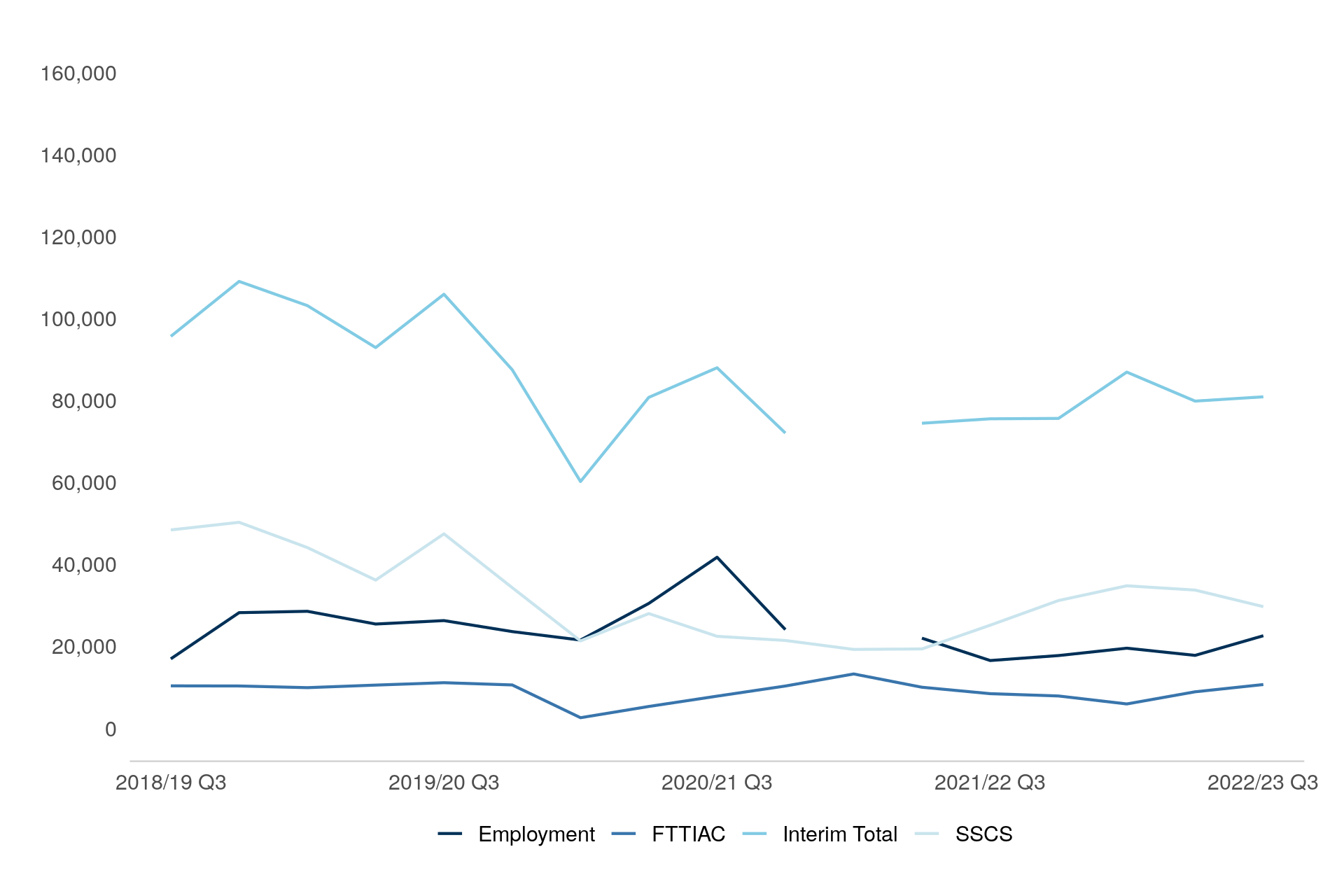
Figure 3.2: Disposals interim totals, Q3 2018/19 to Q3 2022/23 (Source: Table S_3)

Figure 3.3: Caseload outstanding[footnote 2] interim totals, Q3 2018/19 to Q3 2022/23 (Source: Table S_4)
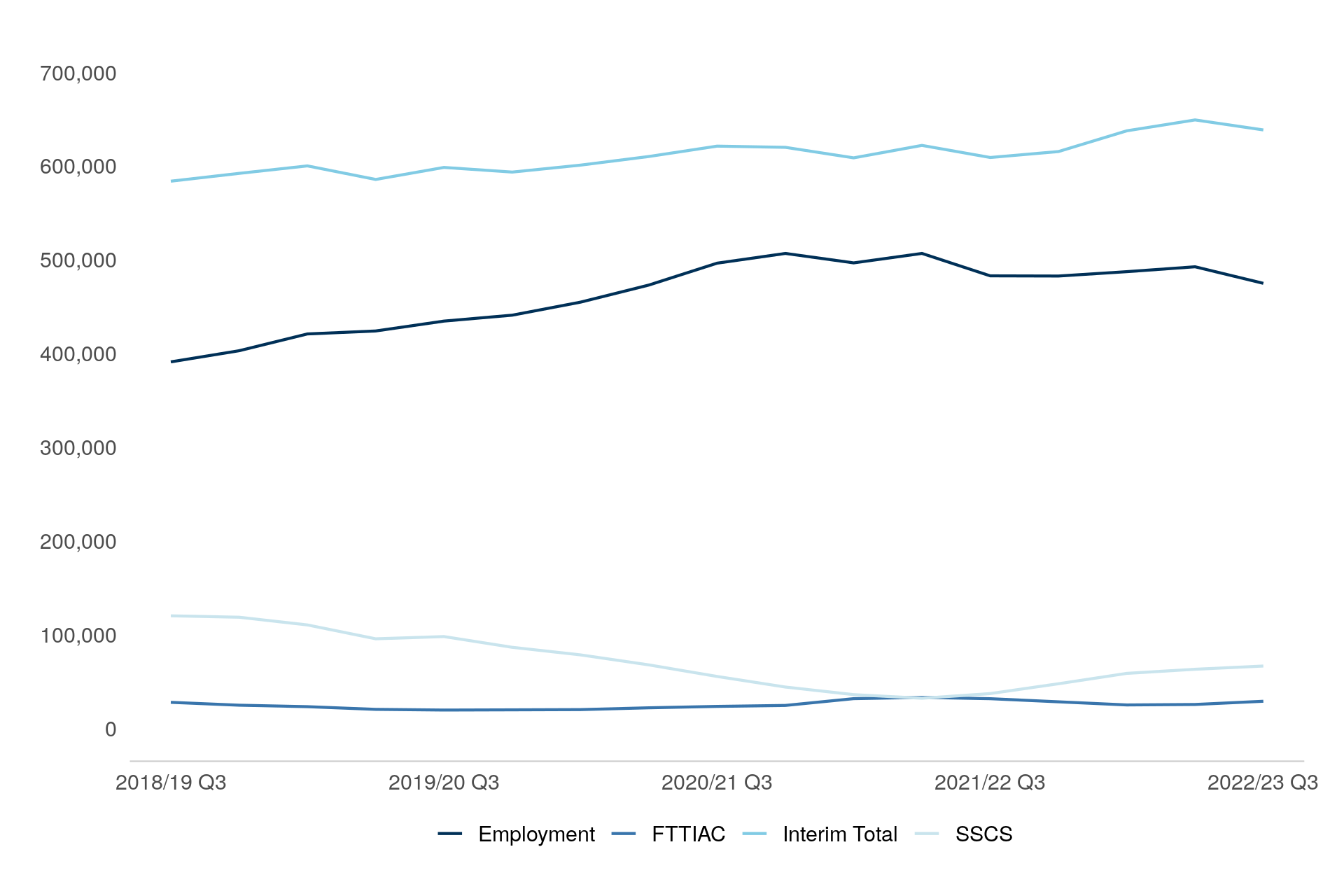
The charts above show the trends in receipts, disposals and caseload outstanding over the last five years for SSCS, FTTIAC, ET, and all tribunals overall (using the Interim[footnote 1] Total measure).
In October to December 2022, overall interim[footnote 1] receipts increased by 7% compared to October to December 2021. This was driven by increases in ET and SSCS (by 37% and 18% respectively).
Overall interim[footnote 1] disposals decreased by 15% in October to December 2022 (to 74,000). The FTTIAC disposed of 24% less cases in Q3 2022/23 compared to Q3 2021/22. SSCS disposals increased by 68% over the same period.
4. Social Security and Child Support
SSCS receipts, disposals and caseload outstanding all increased
Compared to the same period in 2021, Social Security and Child Support (SSCS) receipts, disposals and caseload outstanding all increased by 18%, 68% and 79% respectively.
In October to December 2022, 61% of disposals were cleared at hearing with a 62% overturn rate
Of the 32,000 disposals in Q3 2022/23, 61% were cleared at a hearing and of these, 62% had the initial decision revised in favour of the claimant (unchanged and up from 60% in the same period in 2021/22 respectively).
Figure 4.1: Social Security and Child Support receipts, Q3 2018/19 to Q3 2022/23 (Source: Tables SSCS_1)

Figure 4.2: Social Security and Child Support disposals, Q3 2018/19 to Q3 2022/23 (Source: Tables SSCS_2)
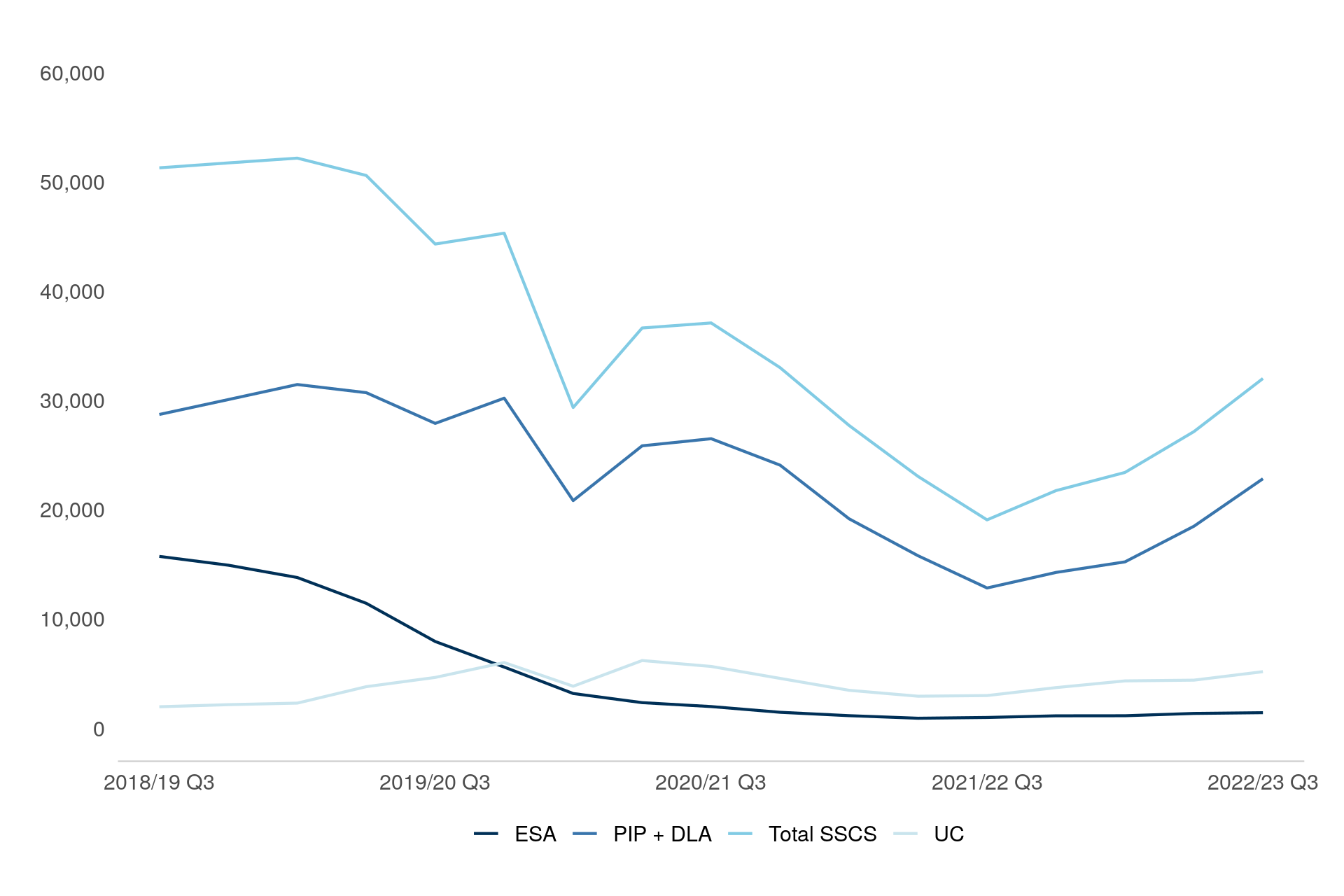
Figure 4.3: Social Security and Child Support caseload outstanding, Q3 2018/19 to Q3 2022/23 (Source: Tables S_4)

The economic impact of the COVID-19 pandemic resulted in an increase in the number of people on Universal Credit[footnote 3] as the employment rate decreased and economic inactivity increased. The Department for Work and Pensions (DWP) changes to benefit processes in response to the pandemic, such as the temporary suspension of face-to-face assessments for health and disability-related benefits, contributed to the general downward trend in receipts seen during the pandemic. However, as the policies put in place due to COVID-19 came to an end and restrictions were eased, we are now seeing SSCS receipts increasing significantly since Q2 2021/22 although they are still below pre-Covid19 levels.
SSCS receipts increased by 18% this quarter, to 30,000 appeals, compared to October to December 2021. This was driven by increases in Personal Independence Payment and Universal Credit (by 32% and 5% respectively). PIP and UC appeals accounted for 66% and 18% respectively of all SSCS receipts in October to December 2022.
In October to December 2022, SSCS disposals increased by 68% when compared to the same period in 2021 (from 19,000 in Q3 2021/22 to 32,000 in Q3 2022/23). PIP made up two thirds (68%) and UC 16% of SSCS disposals.
Of the disposals made by the SSCS tribunal, 19,000 (61%) were cleared at hearing, and of these, 62% were overturned in favour of the customer (no change from 61% and up from 60% on the same period in 2021 respectively). This overturn rate varied by benefit type, with PIP at 69%, Disability Living Allowance (DLA) 61%, Employment Support Allowance (ESA) 49%, and UC 53%. The PIP, DLA, ESA and UC overturn rates mostly decreased compared with October to December 2021 (PIP up 1, DLA down 5, ESA down 11 and UC down 7 percentage points).
There were 67,000 SSCS cases outstanding at the end of December 2022, an increase of 79% compared to the same period in 2021. Since Q4 2017/18, caseload outstanding had been gradually decreasing (from a peak of 125,000), only rising in Q3 2019/20. However, SSCS caseload outstanding has started to rise again, increasing when compared to equivalent periods in each of the last five quarters (Q3 and Q4 2021/22, and Q1 Q2 and Q3 2022/23).
Of those cases disposed of by the SSCS tribunal in October to December 2022, the mean age of a case at disposal was 24 weeks, a week’s increase compared to the same period in 2021 (see tables T_2).
5. Immigration and Asylum
First-tier Tribunal Immigration and Asylum Chamber (FTTIAC)
In October to December 2022, FTTIAC receipts increased by 26% to 11,000, compared to Q3 2021/22. Disposals decreased by 24% (to 8,000), over the same period.
In the same period, caseload outstanding decreased by 9% (to 29,000).
Figure 5.1: First-tier Tribunal Immigration and Asylum Chamber receipts, Q3 2018/19 to Q3 2022/23 (Source: Tables FIA_1)
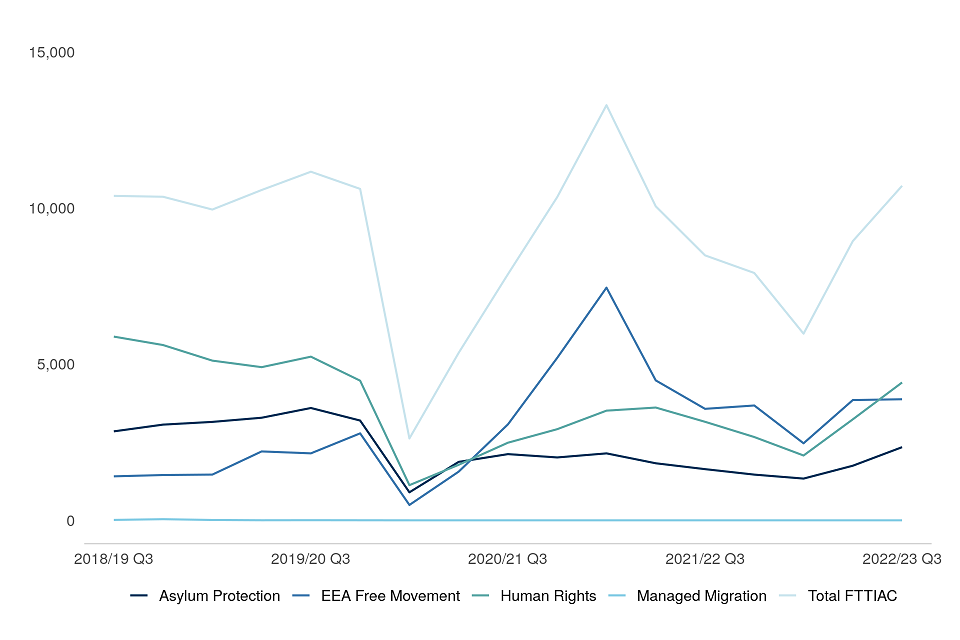
Figure 5.2: First-tier Tribunal Immigration and Asylum Chamber disposals, Q3 2018/19 to Q3 2022/23 (Source: Tables FIA_2)

Figure 5.3: First-tier Tribunal Immigration and Asylum Chamber caseload outstanding, Q3 2018/19 to Q3 2022/23 (Source: Tables S_4)

Following on from a steep fall in 2020/21 due to the impact of the pandemic, FTTIAC receipts started to return to pre-Covid19 levels over the course of 2021/22. In 2021/22, FTTIAC receipts increased by 52% (to 40,000) compared to 2020/21. This quarter receipts increased by 26% (to 11,000) compared to the same period last year.
The proportion of EEA/EUSS receipts has been increasing steadily since 30 June 2021, the deadline for the majority of those applying to the EUSS. Applicants with reasonable grounds for missing the deadline can still apply, more information on this can be found at: Rights of EU and EEA citizens – GOV.UK (www.gov.uk). The EEA/EUSS receipts now make up 36% of all FTTIAC receipts. In October to December 2022, there were 3,900 EEA/EUSS receipts, an increase of 9% compared to the same period last year.
Compared to Q3 2021/22, Human Rights (HR) receipts increased by 40% to 4,400. Asylum/Protection (AP) receipts increased by 43% compared to the same period in 2021 (to 2,300). HR and AP proportionally represented 41% and 22% of all FTTIAC receipts respectively (up 4 and up 3 percentage points respectively from a year ago).
In Q3 2022/23, FTTIAC disposals decreased by 24% to 8,000. This fall in disposals was driven by decreases in EEA Free Movement and Asylum/Protection/Revocation of Protection (by 39% and 16% respectively). EEA appeals made up the largest proportion (42%) of all FTTIAC disposals in October to December 2022, down from 52% a year ago.
Of the disposals made in the FTTIAC this quarter, 63% were determined i.e. a decision was made by a judge at a hearing or on the papers (compared to 64% in Q3 2021/22); 17% were withdrawn (compared to 18% in Q3 2021/22); 6% were struck out for non-payment of the appeal fee (compared to 7% in Q3 2021/22), and 4% were invalid or out of time (compared to 2% in Q3 2021/22). Around half (48%) of the 5,000 cases determined at a hearing or on the papers were allowed/granted, although this varied by case type (48% of Asylum/Protection, 53% of Human Rights and 44% of EEA Free Movement appeals were allowed/granted).
In the FTTIAC, the mean time taken to clear appeals across all categories is at 41 weeks this quarter, which is 2 weeks more than compared to the same period a year ago. Asylum/Protection, Human Rights and EEA Free Movement had mean times taken of 54 weeks, 45 weeks and 39 weeks respectively.
Upper Tribunal Immigration and Asylum Chamber (UTIAC)
In Q3 2022/23 UTIAC Judicial Review receipts increased by 33%, to 590, compared to the same period a year ago. Disposals increased by 61% to 590 whilst caseload outstanding rose by 68%, to 1,100, compared to October to December 2021.
UTIAC Immigration and Asylum Judicial Reviews
In October to December 2022, there were 590 Immigration and Asylum Judicial Review receipts and 590 disposals, an increase of 33% and an increase of 61% respectively on October to December 2021.
Of the 590 Immigration and Asylum Judicial Reviews disposed of 44% were determined and 2% were transferred to the Administrative Court. The remaining 54% were in the ‘Other’ category, which includes cases that were withdrawn or not served.
During October to December 2022, 290 UTIAC Judicial Review applications were determined by paper hearing, of which 12% were allowed to continue to the substantive hearing stage. A further 21 were reconsidered at an oral renewal, of which 100% were allowed to continue to the substantive hearing stage. There were 16 substantive hearings which were determined in October to December 2022 of which 19% were granted in favour of the appellant (see table UIA_3).
6. Employment Tribunals
Employment Tribunal single cases
In Q3 2022, the Employment Tribunal received 7,600 single claim receipts and disposed of 7,300 single claim cases. There were 45,000 single claim cases outstanding at the end of December.
Employment Tribunal multiple cases
This quarter there were 15,000 Multiple claim receipts, 9,700 disposals and caseload outstanding stood at 430,000 at the end of December.
Employment Tribunals transitioned to a new database (Employment Case Management) during March to May 2021. It has not been possible to provide full results from both databases during this migration period on a consistent basis. Therefore, Employment Tribunal (ET) data is not available for Q1 2021/22, and as a result we are unable to present data for the full financial year of 2021/22. The data is still subject to checks, but there is increasing confidence in the numbers for receipts, disposals and caseloads outstanding which we present in this report. Jurisdictional breakdowns for disposals, timeliness and outcome data are still undergoing more rigorous checks and will not be presented until the checks are complete. In addition, because of the operational differences between ECM and the previous database, caution should be exercised when making comparisons in the statistical results before and after migration.
In Q3 2022/23, there were 23,000 Employment Tribunals (ET) receipts, 33% (7,600) of which were single claims receipts, and the remaining 67% (15,000) were multiple claims receipts. The ET disposed of 17,000 cases in Q3 2022/23. At the end of December 2022, 475,000 cases were outstanding.
Figure 6.1: Index of Employment Tribunals single and multiple claim receipts, Q3 2018/19 to Q3 2022/23 (Source: Tables S_2)
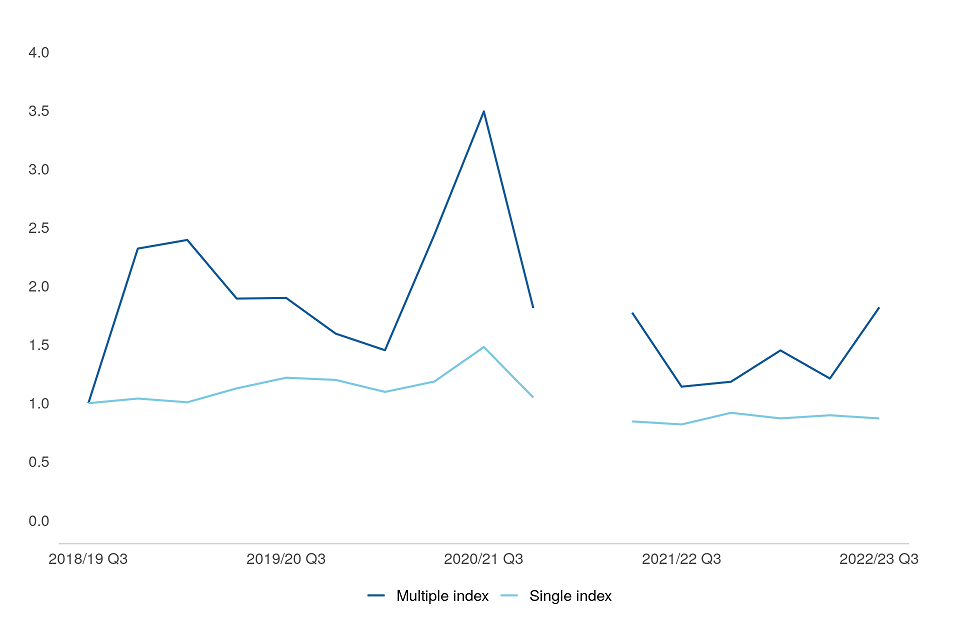
* Baseline 2018/19 Q3
Figure 6.2: Index of Employment Tribunals single and multiple claim disposals, Q3 2018/19 to Q3 2022/23 (Source: Tables S_3)
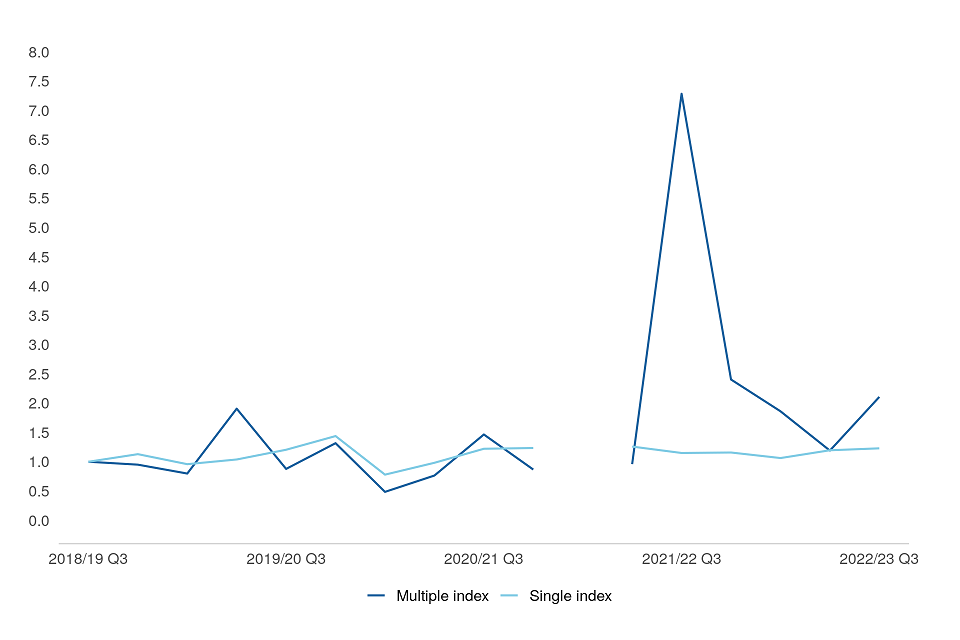
* Baseline 2018/19 Q3
Figure 6.3: Index of Employment Tribunals single and multiple claims outstanding, Q3 2018/19 to Q3 2022/23 (Source: Tables S_4)

* Baseline 2018/19 Q3
Single claim receipts have returned to levels seen prior to the COVID-19 pandemic. Single claim caseload outstanding (at 45,000) continues to rise having passed the peak levels seen in 2009/10 (when it was 36,000 in Q2 of that year), driven by disposals being continuously lower than receipts.
There were 15,000 multiple claims received this quarter. Multiple claims tend to be more volatile as they can be skewed by a high number of claims against a single employer.
The peak seen in the disposal chart in Q3 2021/22 is due to a large spike in multiple claims. A dismissal judgment was issued in December 2021 for 48,000 British Airways claims covering 71,000 jurisdictions. These claims had been withdrawn over a number of years but given the volume and restrictions with the old case management system these had not been formally closed until now, hence the spike. This figure is expected to be revised again as there is still closure action to take place on some of the claims.
7. Gender Recognition Certificates
271 Gender Recognition Panel (GRP) applications were received and 177 were disposed of between October to December 2022; 607 applications were pending by the end of December 2022
The GRP received 277 this quarter, an increase of 103 compared to October to December 2021. Of the 177 applications disposed of, a full Gender Recognition Certificate (GRC) was granted in 86% of cases (152 full GRCs). The proportion in the same period in 2021 is also 86% (where 109 full GRCs were granted out of 127 disposals).
As expected, GRP receipts have increased annually since 2017/18, particularly more recently following a reduction in the application fee in May 2021 from £140 to £5, and the move to an online application process in July 2022. This has come at the same time as an increase in both the caseload outstanding and refusals. Caseload outstanding reached 608 cases in Q3 2022/23, while 10% of all disposals (18 cases) have been refused. Applications can be refused if they do not meet the required criteria. More information on the criteria can be found at the following link: Apply for a Gender Recognition Certificate - GOV.UK (www.gov.uk) (URL:https://www.gov.uk/apply-gender-recognition-certificate).
Since April 2005/06, when the Gender Recognition Act 2004 came into effect, 69% of interim certificates (171 of the 249 interim GRCs granted) have been converted to a full GRC, 52% of which were converted within 30 weeks. No interim certificates were converted to a full GRC between October to December 2022. Of the 152 full certificates granted in October to December 2022, 18 were for married applicants and 132 for single applicants. 82 (54%) of the individuals granted full certificates were registered male at birth while 70 (46%) were registered female at birth.
Figure 7.1: Applications for Gender Recognition Certificates received, disposed of and pending, Q3 2018/19 to Q3 2022/23 (Source: Tables GRP_1 and GRP_2)
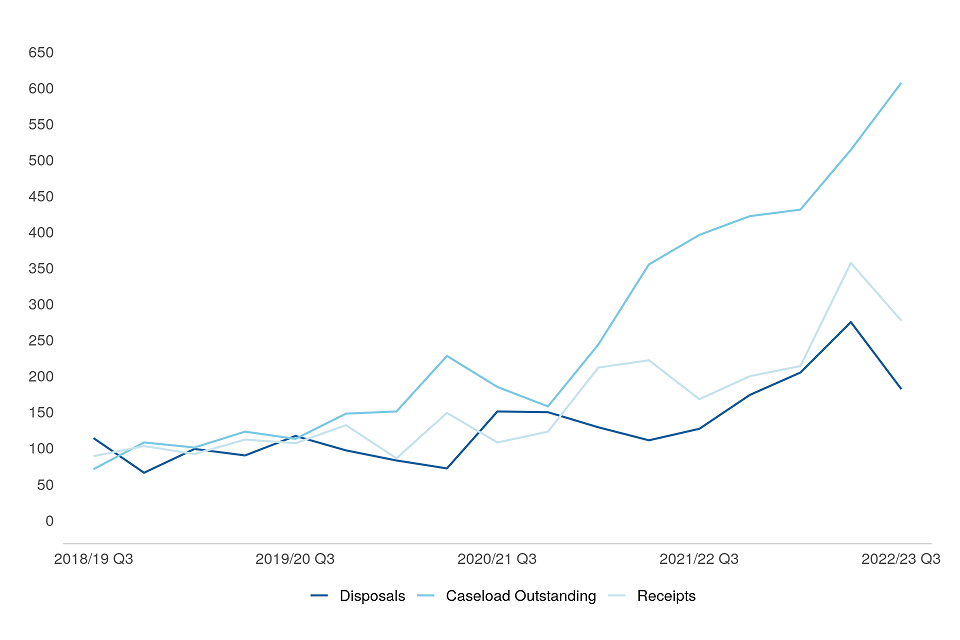
Figure 7.2: Full Gender Recognition Certificates granted by year of birth, 2017/18 to 2021/22 (Source: Table GRP_4)

8. Other Tribunals
Increase in First-tier tax Chamber receipts by 81% compared to the same quarter last year
The First-tier Tax Chamber recorded 2,000 receipts this quarter, a decrease of 81% compared to the same quarter last year. In the same period, 1,500 appeals were disposed of and caseload outstanding increased by 18% (to 45,000). Mental Health receipts, disposals and caseload outstanding all decreased compared to 2021/22
Mental Health receipts, disposals and caseload outstanding all decreased when compared to October to December 2021, down by 5%, 2% and 11% respectively.
First-tier Tax Chamber
There has been a decrease in all case types in the First-tier Tax Chamber this quarter. Receipts decreased by 81%, to 2,000, compared to the same quarter last year. Disposals and caseload outstanding also decreased by 24% and 18% to 1,500 and 45,000 respectively. The figures have fallen in the last two quarters suggesting a possible winding down of the trend started in Q2 2021/22 when Treasury and HMRC increased action against umbrella companies employing potentially fraudulent VAT schemes.
Figure 8.1: First-tier Tax Chamber receipts, disposals and caseload outstanding Q3 2018/19 to Q3 2022/23 (Source: Tables S_2, S_3, and S_4)
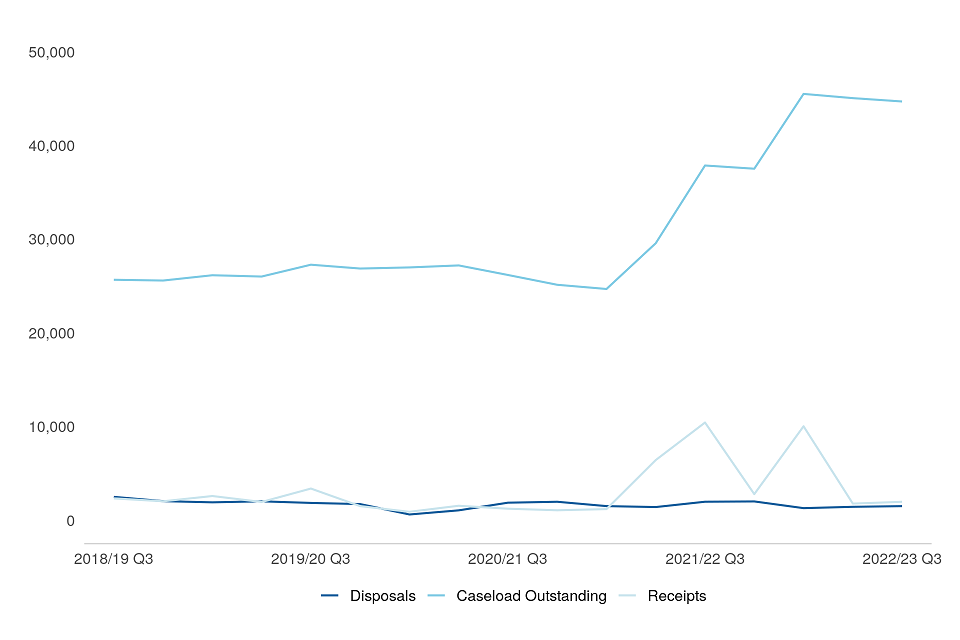
Mental Health
Mental health figures have remained stable this quarter. Receipts decreased by 5% in October to December 2022 (to 7,300), compared to the same period in 2021. The tribunal disposed of 7,800 appeals in Q3 2022/23, a decrease of 2% when compared to Q3 2021/22. There were 3,100 Mental Health cases outstanding at the end of December 2022, a decrease of 11% compared to the same period in 2021.
The mean age of cases at clearance for the Mental Health section 2, Mental Health Restricted Patients, and the Mental Health Non-Restricted Patients case types has remained consistent for the same period in the last couple of years at 0.9, 11.4 and 6.3 respectively.
9. Employment Tribunal Representation
Two thirds of claimants (67%) were represented by a lawyer[footnote 4] in 2021/22, up from 65% in 2020/21. Similarly, 27% of claimants in 2021/22 had no representation recorded[footnote 5], up from 26% in 2020/21.
Costs and Compensation[footnote 6]
In 2021/22, sexual orientation discrimination claims received the largest average award (£33,000) compared to other discrimination jurisdictions. The highest maximum award in 2021/22, was for race discrimination, at £228,000.
Claimant representation is recorded at the time of application and may change as a case progresses. The proportion of claimants represented by a lawyer in 2021/22 was 67%, two percentage points lower than in 2020/21. Representation information was not provided for 27% of claims, up from 1% of claims in 2020/21.
The proportion of claims represented by a lawyer has been increasing in the last 2 years after a period of decline between 2016/17 and 2019/20. This is a similar trend, although not as steeply, for claims with no representation (or where no rep information is provided); a gradual increase in the last 2 years following a period of decline between 2016/17 and 2018/19. Since the introduction of the online system a number of improvements have been made and a direct link to the form can be found on Gov.uk website, improving accessibility.
Figure 9.1: Representation of claimants at Employment Tribunals, 2005/06 to 2021/22 (Source: Table E_1)

Centrally collated cost and compensation data is only published for Unfair Dismissal and each of the discrimination-based cases. In 2021/22, there were 630 claims that received compensation for Unfair Dismissal (up 50% compared to 2020/21), where the maximum award was £165,000 and the average (mean) award was £14,000. The trend in number of unfair dismissal claims receiving compensation has been falling since 2010/11, with small increases recorded in 2018/19 (from 540 claims in 2017/18 to 660 claims and this year (from 420 claims in 2020/21 to 630 in 2021/22).
There were 195 discrimination cases where compensation was awarded in 2021/22; the maximum amount awarded (£228,000) was in the Race Discrimination jurisdiction.
10. Further information
Rounding convention
Figures greater than 10,000 are rounded to the nearest 1,000, those between 1,000 and 10,000 are rounded to the nearest 100 and those between 100 to 1,000 are rounded to the nearest 10. Less than 100 are given as the actual number.
Accompanying files
As well as this bulletin, the following products are published as part of this release:
-
A supporting document providing further information on how the data is collected and processed, as well as information on the revisions policy and legislation relevant to trends and background on the functioning of the tribunal system.
-
The quality statement published with this guide sets out our policies for producing quality statistical outputs for the information we provide to maintain our users’ understanding and trust.
-
A set of overview tables, covering each section of this bulletin and one additional set of tables on Employment Tribunals (for ET Management information – Annex C).
-
A set of CSV files including data on overall receipts and disposals CSV, covering all tribunal types.
-
Additional releases this quarter:
- Update to the statistical notice on Immigration and Asylum (I&A) Detained Immigration Appeals (DIA) to include data to Q3 2022/23.
- Annual ET tables covering the representation of claimants in the ET.
Future publications
Our statisticians regularly review the content of publications. Development of new and improved statistical outputs is usually dependent on reallocating existing resources. As part of our continual review and prioritisation, we welcome user feedback on existing outputs including content, breadth, frequency and methodology. Please send any comments you have on this publication including suggestions for further developments or reductions in content.
Contact
Press enquiries should be directed to the Ministry of Justice or HMCTS press office:
Press Office - Courts and Law - email: pressofficecourtslaw@justice.gov.uk
Other enquiries and feedback on these statistics should be directed to the Data and Evidence as a Service division of the Ministry of Justice:
Rita Kumi-Ampofo or Maisie Terry - email: CAJS@justice.gov.uk
Next update: 8 June 2023 (URL: www.gov.uk/government/collections/tribunals-statistics)
© Crown copyright Produced by the Ministry of Justice
For any feedback on the layout or content of this publication or requests for alternative formats, please contact CAJS@justice.gov.uk
-
The interim totals for the overall volumes of tribunal receipts, disposals and caseload outstanding exclude the Upper Tribunal (Immigration and Asylum Chamber) and Employment Appeal Tribunal for which the data is currently not available. See the main tables S_2, S_3 and S_4 for more information. ↩ ↩2 ↩3 ↩4 ↩5 ↩6 ↩7 ↩8 ↩9 ↩10 ↩11 ↩12 ↩13 ↩14 ↩15
-
Outstanding caseload is based on a snapshot in time based on the last day of each quarter. ↩
-
https://www.gov.uk/government/collections/universal-credit-statistics ↩
-
Includes: represented by Solicitors, Law Centres and Trade Associations. ↩
-
For those individuals representing themselves, there is no need to provide information on representatives. Therefore, all cases where the representative information was left blank are included here. ↩
-
Cost and compensation are awarded per claim, not per jurisdiction. The compensation is usually allocated to the lead jurisdiction in the ET claim only. However, if it is not possible to show which jurisdiction type is the lead, the amount is divided equally for each type. ↩
